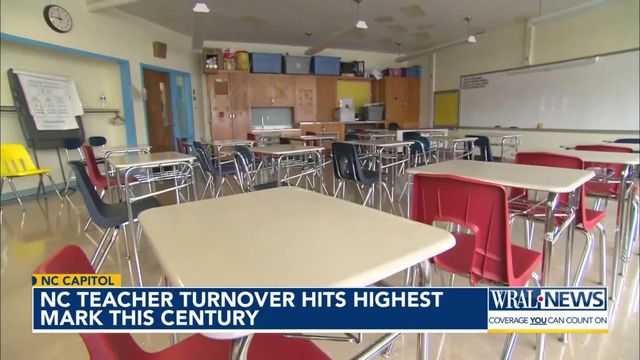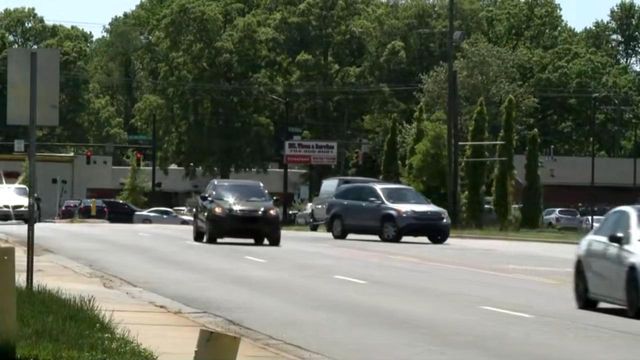NC teacher turnover hits highest mark in decades. New report shows changes in who is leading classrooms
More than 10,000 North Carolina teachers left the state’s classrooms in 2023, the highest 12-month total reported in at least the past two decades, according to a new state report.
The exodus, up 42% from 2022, was fueled in part by resignations among first-year teachers and teachers newly eligible for full or nearly full retirement benefits, the latest State of the Teaching Profession report shows. The report was presented to the State Board of Education on Wednesday. The departures accounted for 11.5% of the state's 90,000 traditional public school teachers.
To deal with turnover in this growing state, schools are turning to people working in other careers, convincing them to become teachers. The number of teachers who came from an alternative route rose to more than 11,000 in 2023, up from about 6,700 the year before. While they aren’t fully licensed teachers, they must work toward a permanent license to stay in the classroom longer than three years.
About 6,000 teaching positions were not filled by a qualified teacher at the beginning of the school year, although some have been filled by someone, such as a long-term substitute teacher or a retired teacher.
The shortage of qualified teachers spans every subject area now, whereas for decades only math, science and special education typically experienced a shortage, according to federal reports.
While schools have been short on teachers meeting certain qualifications, they have successfully improved test scores over the past year, although many school districts are still working toward getting students back to pre-pandemic levels.
Exactly why teachers are leaving is a somewhat murky picture. Teachers often complain of a lack of pay and a lack of support, but exit surveys in North Carolina don't include questions about pay or support. The teacher working conditions survey, administered every two years, also doesn’t ask about pay.
While other issues can contribute to turnover, pay makes a difference, said Kimberly Jones, the state’s Burroughs Wellcome Teacher of the Year and an adviser to the board.
“Is it worth doing this really tough job, with no support, and I owe the federal government a third of my check every month?” she said. “That’s when it’s harder.”
She suggested expanding programs to make attending college to become a teacher more affordable. The General Assembly has greatly shrunk its North Carolina Teaching Fellows program, which covered college tuition for certain students and which helped Jones graduate debt-free.
Public school teaching is a challenging job that has little flexibility and a lot of regulations. Superintendent Catherine Truitt has pushed for an overhaul to teacher licensure that would restructure teaching to include fewer responsibilities and more mentorship for beginning teachers and more leadership opportunities for experienced teachers. The plan would have also drastically raised pay. It was backed by the State Board of Education, but state lawmakers declined to take up the proposal during their regular session last year.
“You have very rigid pay structures that are dependent on very specific types of resumes, where people get paid for doing the same job, whether they do it well or not,” Truitt said. That might not appeal to young professionals, she said.
North Carolina’s teacher workforce is aging, with a continuing drop in beginning teachers.
The number of teachers retiring as soon as they’re eligible for full retirement benefits is up. About one-quarter of those teachers retired in 2023, up from about one-fifth the year before.
A quarter of first-year teachers quit, from about one in seven the year before.
“It’s interesting to me that somebody wants to go into teaching and after one year it’s no longer a desirable profession for them,” said Tom Tomberlin, senior director of the Department of Public Instruction’s Office of Educator Preparation and Teacher Licensure. Tomberlin, who presented the report to the board, said first-year teachers have told DPI they feel a lack of support and unmanageable workloads.
State lawmakers have increased pay for beginning teachers in recent years, hoping to improve recruitment and retention for early-career teachers. But increasingly, beginning teachers are people who are mid-career and looking for a change.
First-year teachers have described to WRAL News long work weeks and feelings of overwhelm, despite an enthusiasm for helping kids learn.
“The answer is we have to stop expecting a first-year teacher to do the same job as a 20-year, 30-year teacher,” Truitt said. “Law clerks don’t start off doing the exact same job as someone who’s been there six years.”
A separate report to the State Board of Education showed declining enrollment in the state’s educator preparation programs. From two years ago to last year, enrollment dropped 10%, to 15,865 people pursuing a teaching license.
While it’s up from 10 years ago, it’s less than what the state needs to replace teachers who are leaving the profession, whether through a move, retirement, resignation or promotion to an administrative position. That’s caused schools to try to recruit people people from other professions who are looking to make a career switch.
Tomberlin and others called those new, career-switching teachers a “silver lining,” showing that many people are still interested in entering the classroom.













